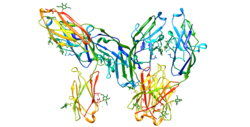Clinical significance
CD33 is the target of gemtuzumab ozogamicin (trade name: Mylotarg®; Pfizer/Wyeth-Ayerst Laboratories), [13] an antibody-drug conjugate (ADC) for the treatment of patients with acute myeloid leukemia. The drug is a recombinant, humanized anti-CD33 monoclonal antibody (IgG4 κ antibody hP67.6) covalently attached to the cytotoxic antitumor antibiotic calicheamicin (N-acetyl-γ-calicheamicin) via a bifunctional linker (4-(4-acetylphenoxy)butanoic acid). [14] Several mechanisms of resistance to gemtuzumab ozogamicin have been elucidated. [15] On September 1, 2017, the FDA approved Pfizer's Mylotarg. [16]
Gemtuzumab ozogamicin was initially approved by the U.S. Food and Drug Administration in 2000. However, during post marketing clinical trials researchers noticed a greater number of deaths in the group of patients who received gemtuzumab ozogamicin compared with those receiving chemotherapy alone. Based on these results, Pfizer voluntarily withdrew gemtuzumab ozogamicin from the market in mid-2010, but was reintroduced to the market in 2017. [17] [18] [19]
CD33 is also the target in Vadastuximab talirine (SGN-CD33A), a novel antibody-drug conjugate being developed by Seattle Genetics, utilizing this company's ADC technology. [20]
This page is based on this
Wikipedia article Text is available under the
CC BY-SA 4.0 license; additional terms may apply.
Images, videos and audio are available under their respective licenses.




